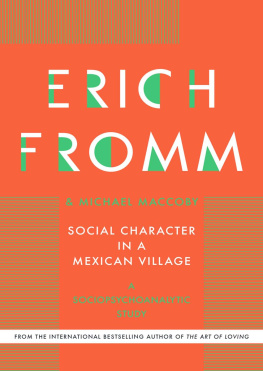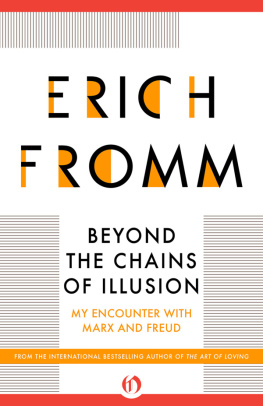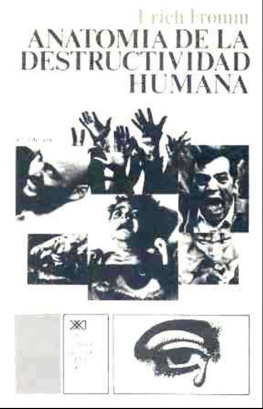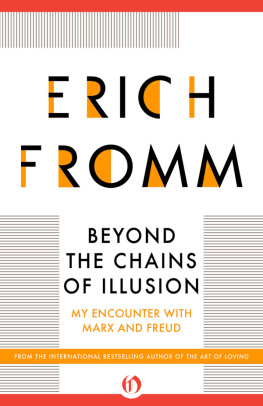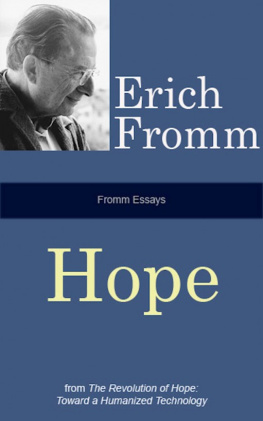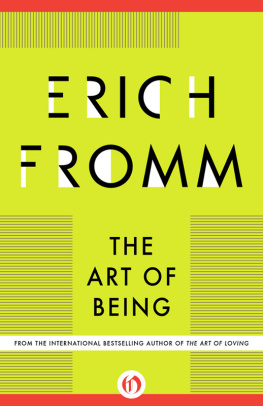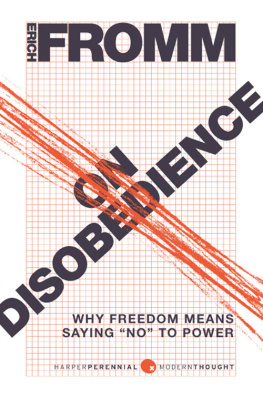Erich Fromm - Social Character in a Mexican Village: A Sociopsychoanalytic Study
Here you can read online Erich Fromm - Social Character in a Mexican Village: A Sociopsychoanalytic Study full text of the book (entire story) in english for free. Download pdf and epub, get meaning, cover and reviews about this ebook. year: 2014, publisher: Open Road Distribution, genre: Romance novel. Description of the work, (preface) as well as reviews are available. Best literature library LitArk.com created for fans of good reading and offers a wide selection of genres:
Romance novel
Science fiction
Adventure
Detective
Science
History
Home and family
Prose
Art
Politics
Computer
Non-fiction
Religion
Business
Children
Humor
Choose a favorite category and find really read worthwhile books. Enjoy immersion in the world of imagination, feel the emotions of the characters or learn something new for yourself, make an fascinating discovery.
- Book:Social Character in a Mexican Village: A Sociopsychoanalytic Study
- Author:
- Publisher:Open Road Distribution
- Genre:
- Year:2014
- Rating:3 / 5
- Favourites:Add to favourites
- Your mark:
- 60
- 1
- 2
- 3
- 4
- 5
Social Character in a Mexican Village: A Sociopsychoanalytic Study: summary, description and annotation
We offer to read an annotation, description, summary or preface (depends on what the author of the book "Social Character in a Mexican Village: A Sociopsychoanalytic Study" wrote himself). If you haven't found the necessary information about the book — write in the comments, we will try to find it.
Social Character in a Mexican Village: A Sociopsychoanalytic Study — read online for free the complete book (whole text) full work
Below is the text of the book, divided by pages. System saving the place of the last page read, allows you to conveniently read the book "Social Character in a Mexican Village: A Sociopsychoanalytic Study" online for free, without having to search again every time where you left off. Put a bookmark, and you can go to the page where you finished reading at any time.
Font size:
Interval:
Bookmark:
Social Character in a Mexican Village
A Sociopsychoanalytic Study
Erich Fromm and Michael Maccoby
Contents
Factor II-Productiveness vs. Unproductiveness
The Village Boys Club
The Social Character of the Peasant and Problems of Methodology
This study deals with the social character of the Mexican peasant. Its aim is to analyze the interrelations and interactions between his emotional attitudes rooted in his character and the socioeconomic conditions under which he lives.
The Peasant
In this introductory chapter we need to discuss the basic concepts in our investigations: the concept of the peasant and of peasant character; the dynamic concept of character and of social character, and the problem of methodology in the study of the social character.
What is a peasant? In the following we call peasants such villagers whose main occupation is farming, although they may also work as potters or fishermen. The English word peasant, like the Spanish word campesino, means a man of the countryside, of the land. However, peasants are distinguished from both modern farmers and many indigenous tribesmen who also work the land.
Unlike that of the modern farmer, the peasants mode of production is highly individualistic. The peasant works close to the margin of subsistence. He does not have the capital or the technology employed by the modern farmer. He works alone or with his family, with one or several hired hands, using no more complicated tools than a hoe and a plow.
The peasant differs from most indigenous tribesmen in that he is dependent on the urban society, economically, culturally, and politically. He must sell his produce in urban markets, and in exchange he needs money to buy the goods produced in the city. His religion, many of his medical practices,
In this definition of peasantry, one theoretical problem remains. How do we define the agricultural worker who is not an independent small farmer, but who works as a peon, or day laborer (jornalero), on a plantation or hacienda? Like the peasant, the peon uses rudimentary methods. Like the free peasant he depends on the city for his culture and religion, and he is even more powerless, economically and politically. The essential difference lies in the fact that the peasant ownslegally or factuallyhis land and is dependent only on nature and the market; on the other hand the peon resembles a serf more than a free peasant. The peon class might be defined in S. Mintzs terms as rural proletarians. Peasant villages, such as the one we have studied, frequently have a population made up of both peasants and peons.
Over half the population of the world still lives in peasant villages. Increasingly, peasants are being subjected to new pressures as most countries, with the exception of those that are highly industrialized, are trying to move from an agricultural to a partly or mainly industrial production. In the process of industrial development, a number of people from the countryside are swelling the population of the cities where to make a living they must adapt to work that is different from what they have known before. At the same time, new demands for greater production are being made on the farmers who are expected to feed growing populations and support the process of industrialization. The peasant is expected to change both his attitudes and techniques to satisfy new goals set by the city.
The traditional peasant agriculture produced only the surplus necessary to provide the food for a small and relatively stable population. However, in the modern world, agriculture is expected to provide for an overgrowing population. Technological advances in agriculture offer the promise of greatly increasing production. For the first time in thousands of years the human and animal driven plough, in its more or less developed forms, is being replaced by the tractor, and the work done by the human arm can be done by machines for ploughing, planting, and harvesting. New seeds requiring careful fertilization, such as the Mexican dwarf wheat, promise much greater yields to feed hungry populations. The peasant can become a farmer who uses techniques and methods entirely different from those that characterized agriculture in past history.
How does this change take place? What does it require humanly? Not only does the peasant have to use complicated machines, but optimal production also requires a change from his traditional individualistic form of work. To learn new techniques, he must cooperate with extension services, try out hybrid seeds and new methods, and work in coordination with others. He may need to cooperate with others by fitting himself into an overall plan as it exists in large farming enterprises, be they cooperative, capitalist, or communist.
From the traditional peasants point of view, the new agricultural technology may be felt as more a threat than an opportunity. It requires that he learn new skills and change deep-rooted attitudes. Yet, if he does not adapt to the new technology, he runs the risk of being overrun. In capitalistic countries, he is unable to compete with the agricultural entrepreneurs who are the first to employ the new methods. In communist countries, peasants have been forced even more directly to adapt to the new system. In all of these countries, it is not possible for the peasant to stand still. The new technology and social forms have upset the traditional society.
It is often assumed that the new tasks and the changed ways of functioningeither for industrial work or mechanized farmingrequire merely schooling and some technical training. From this viewpoint education is all the peasant needs in order to adjust himself to the demands of industrial society. However, experiences throughout the world show that schooling and technical knowledge are not enough to transform the old-fashioned peasant into a modern farmer even when he wants to learn the new methods. Indeed, as we shall see in Chapter 3, the schooling received by villagers is not likely to be of use to them in their work. Those who have studied the problem closely conclude that a change of attitudes, or, as we would prefer to say, character, is required before literacy and new technological knowledge will make any decisive difference. It seems to us, as we shall try to explain later, that this attitude fits in best with the mode of production of traditional agriculture, while it does not fit in with the requirements of mechanized or industrial agriculture. The farmer in the industrial society must be open to new ideas, cooperative to a certain degree, capable of planning and investing for the future, and hence willing to spend something now, the reward for which accrues only at a future time. In all countries in the process of industrializationboth capitalistic and communistica lag is to be found between new technological possibilities and the peasants ability to adapt his personality to making use of the new ways. This holds true for most countries within the Soviet bloc, for most of Asia, for countries in the Mediterranean area, as well as for a number of Latin American countries. (The same difficulty existed, of course, for the transformation of the peasant in Northern Europe and the United States from the 19th to the beginning of the 20th century. This transformation, however, was a very slow one compared with the rapid pace of industrialization taking place now and expected in the future in many of the countries just mentioned.)
Next pageFont size:
Interval:
Bookmark:
Similar books «Social Character in a Mexican Village: A Sociopsychoanalytic Study»
Look at similar books to Social Character in a Mexican Village: A Sociopsychoanalytic Study. We have selected literature similar in name and meaning in the hope of providing readers with more options to find new, interesting, not yet read works.
Discussion, reviews of the book Social Character in a Mexican Village: A Sociopsychoanalytic Study and just readers' own opinions. Leave your comments, write what you think about the work, its meaning or the main characters. Specify what exactly you liked and what you didn't like, and why you think so.

